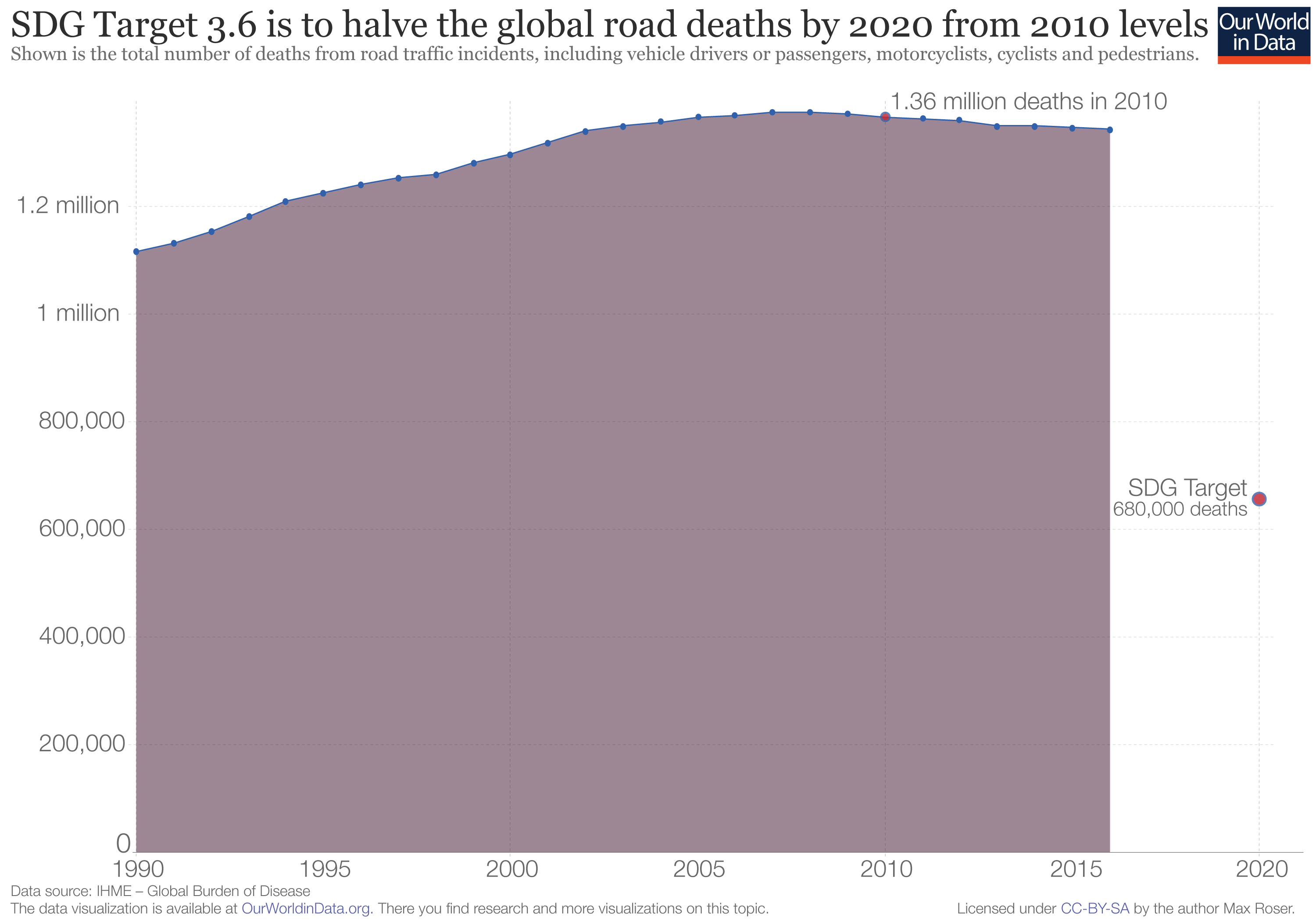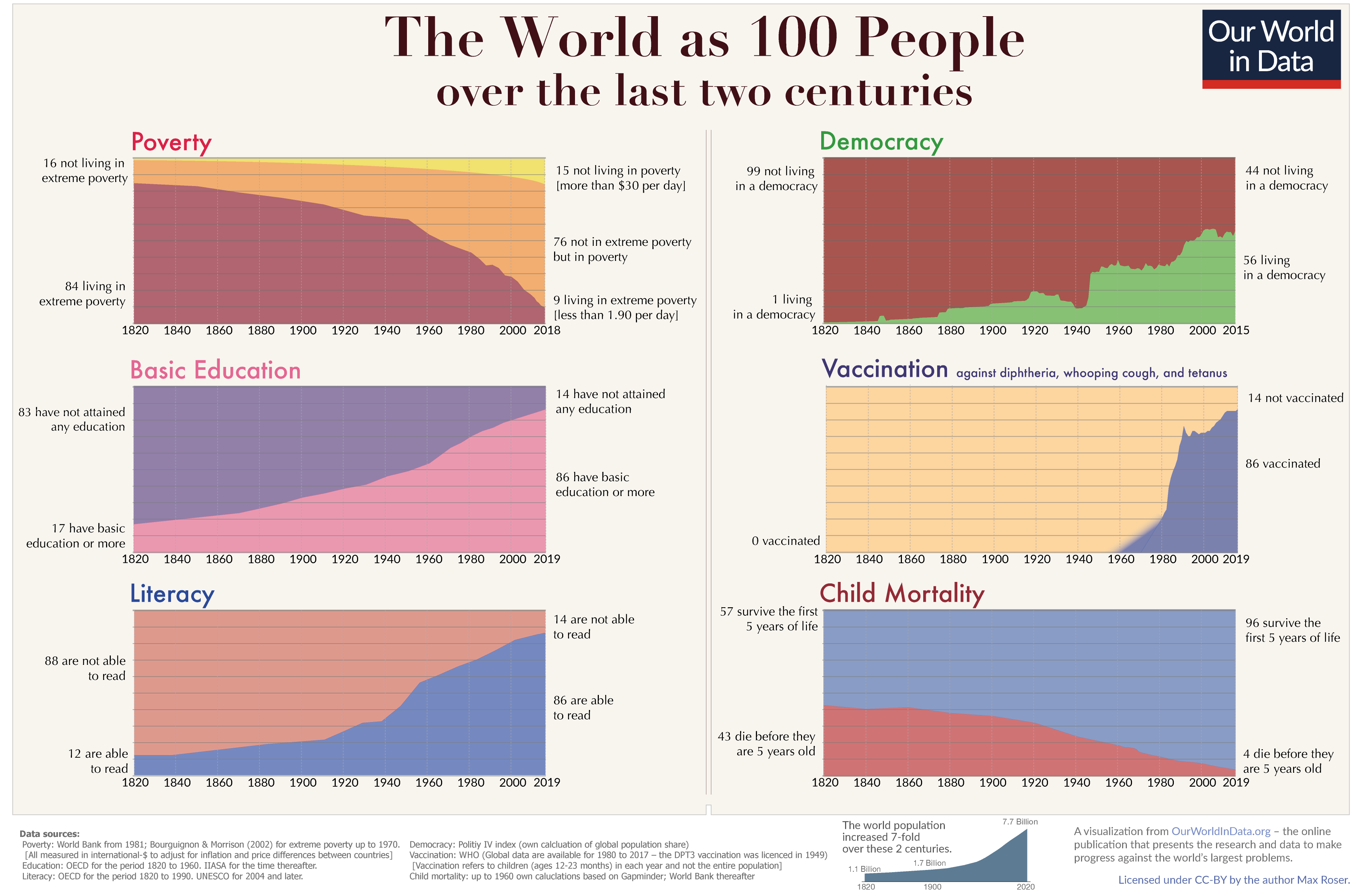The longterm change of global living conditions – and our possibilities for the future.
prepared for the UN Executive Committee
by Max Roser based on our work at www.OurWorldInData.org
What are the perceived global trends?

Few people know how global poverty is changing. The majority thinks that the share of people in extreme poverty is increasing, another quarter believes it is stagnating or admits to not know the answer. Shown is the average answer across 28 countries.

Most people are also not aware that child mortality is falling around the world. Many think that global health is either stagnating or even getting worse.

And if you ask people more generally whether "all things considered, do you think the world is getting better or worse" then most people – 62% – answer that things are getting worse. The perceived global trend is one of global stagnation or even decline. Few have a positive view on how the world is changing. And this matters for what we think is possible in the future.

For the future, very few people think that things will get better. If you ask people the question "Over the next 15 years, do you think living conditions for people around the world will get better or worse?" the majority expects stagnation or worsening. Few people are optimistic about what is possible for future living conditions. If you look at this country by country, you see that particularly in rich countries, most people think that the world will be stagnating or getting worse.
Let's look at the evidence: How is the world changing?

1 – Extreme poverty The share of the world population in extreme poverty declined from almost everyone two centuries ago to below 10%. [Here is the research with all details on this.]

2 – Child health In 1800, 43% of the world's population died as young children. In the latest data it is below 5% – ten-fold lower. But a child mortality rate of 4.5% still means that 11 children die every minute. There is obviously absolutely no reason to be complacent.
In every country of the world every third child died before it was 5 years old. Here is the world map of child mortality in the past. Press play to see the change since then.What do these global developments mean for our future?

The situation today: Still almost every tenth person in the world is living in conditions of extreme poverty.

The Sustainable Development Goal #1 is clear: "By 2030, eradicate extreme poverty for all people everywhere". The World Bank has the goal of reducing extreme poverty to below 3% until 2030. Taking into account the projected rise of the world population this means that the goal is that fewer than 257 million live in extreme poverty in 2030. Are we on track to reach SDG 1?

Projections by Crespo Cuaresma et al. published in 'Nature' this year show that the number of people in extreme poverty will continue to fall if current trends persist. The world is not on track to reach SDG 1. Reference: Crespo Cuaresma et al. (2018) – Will the Sustainable Development Goals be fulfilled? Assessing present and future global poverty. Online here. [Projections of the share of the world population in extreme poverty are here.]

For many SDGs it is not yet possible to know whether we will reach them, because the target is set for 2030, still 12 years away. There are a several SDGs however for which the goal is set for an earlier deadline. Road deaths are one of the most common causes of deaths for young people. Target 3.6. is to halve the number of global road deaths until 2020 (relative to the level of 2010). Unfortunately we cannot realistically hope that we achieve this goal.

Statistics can seem abstract, but what they report really matters: A fall of the global child mortality rate means that millions of children who would otherwise die at a young age can live.

If the world would stagnate at the current level of the child mortality rate it would mean that every year around 6.5 million children die.

However, if the world can follow the path that the UN projects for child mortality rates, it means that compared with a stagnating world 2 million children fewer would die in 2030.

Achieving the SDGs would mean that yet another 2 million children will not die in 2030. The difference however between the projected path and the path required for the SDGs shows that the world is moving in the right direction, but not fast enough.

The comparison with the trajectories for the US and Western Europe shows how very ambitious the development goal is. The world has to reduce the rate of child deaths much faster than these two regions when they were at the same level of child mortality.
What can help us to make it work?
1) There are positive changes in the world that we can benefit from. 2) We need to take the data very seriously. Learn from the data we have and use it to get momentum behind the goals we set ourselves.

The number of children increased from less than 1 billion in 1950 to almost 2 billion today. In the future however this trend will not continue. The number of children in the world will hardly increase, we are close to 'peak child'. Further information: In my post 'When will the world reach 'peak child'?' I discuss how uncertain these projections are and how investments in education today will result into a much smaller world population at the end of the century. The literature on the drivers of falling fertility I have recently summarized here.

Important improvements in global health
This progress continues. One of the main killers of children is malaria. Here is the perspective on the global change in the last 15 years. In many parts of the world malaria has been eradicated (in the US in 1951) and around the world, malaria mortality figures are falling. In the last 15 years the number of malaria deaths was almost halved.
Violence & conflict The history of war deaths. War and conflict is closely linked to the stagnation of living conditions of the world's worst-off. Poverty is increasingly concentrated in fragile/conflict states and looking ahead this is a key challenge.

Income inequality receives a lot of attention
It is a widespread misconception that inequality is on the rise everywhere. Different countries are on very different trajectories. This makes very clear that rising inequality is not inevitable. Inequality is to a substantial degree a matter of political choice.
Global economic inequality
In 1800 the global income inequality was relatively low. Almost everyone was extremely poor.
Global economic inequality
Over the following 175 years global inequality increased very substantively. Some ccountries – particularly in Europe and North America – got rich, while others stayed poor.
Global economic inequality
The most recent episode of global history is different. Global inequality is now falling. But the inequality globally is still extremely high. The incomes of people around the world are largely determined by where they live. Dominating all your efforts and all the skills you are born with, the country where you happen to live explains two-thirds of the variation of incomes across the world – see Branko Milanovic's research here.
The catch-up of poorer world regions has important consequences for science and technology. The regions that got rich first have also been the center of innovation. This will change as incomes in recently much poorer regions are rising. This can have benefits for people in all regions of the world.

Increasing incomes will mean more migration in the coming decades. This figure is taken from Clemens – Does Development Reduce Migration? The research paper is published here.

But the main reason I am cautiously optimistic for the future is the change that we see in education. We can see how the world will change when we compare the education of the old generation with the generation of the young generation.

The younger generation is much better educated.

The perspective that data offers:
– Better health
– Fewer in poverty
– Better education
We are in a strong position, to work on the big problems collectively. This is from my text "A short history of global living conditions and why it matters that we know it".

We need to take data on global development much more seriously.
First reason: Those who know more about how the world is changing are more optimistic about the world.

We need to take data on global development much more seriously.
First reason: Those who know more about how the world is changing are more optimistic about the world.

We need to take data on global development much more seriously.
First reason: Those who know more about how the world is changing are more optimistic about the world.

We need to take data on global development much more seriously.
First reason: Those who know more about how the world is changing are more optimistic about the world.

We need to take data on global development much more seriously.
First reason: Those who know more about how the world is changing are more optimistic about the world.
We need to take data on global development much more seriously.
The second reason why we need data: Statistics are a tool for social change. We need reliable, understandable data to put pressure on governments to achieve the development goals we have. It is coincidence that I was invited to speak here this week, but it is good timing as we just released the new verion of our website 'SDG-Tracker.org'. It is the first publication that allows policy makers and citizens around the world to see how the world is doing on the way to the Sustainable Development Goals in 2030.